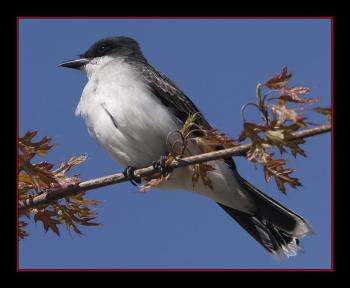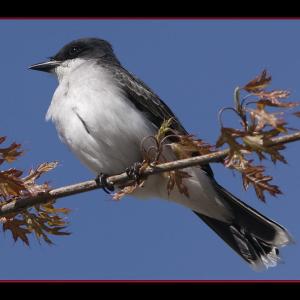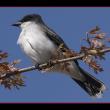A tyrant among us
Imagine a bird a little smaller than a robin that vigorously attacks every crow, hawk, osprey – even a massive eagle – that dares fly over its territory.
Imagine no more: such a bird lives among us, and for its propensity and determination to defend itself, family and territory, it is a bird worthy of admiration. It is the Eastern kingbird, and even its scientific name (tyrannus tyrannus) suggests its tyrannical and pugnacious demeanor.
The Eastern kingbird is one of the many species in the family of birds known as flycatchers. They do indeed eat insects for much of the year, and in the case of the Eastern kingbird, it is quite common to see them alongside a river, stream, lake, pond or other wetland sallying out from a tree top on swiftly beating wings to snag a flying insect from the air.
They are strikingly marked, with black above contrasting with white below and with a white tip to their black tail. Perhaps it comes as no surprise that these energetic birds also tend to be loud and chattery during the breeding season, even when they are not going after a hawk or crow.
But it’s when a large bird, like a crow or hawk, flies over that the full and true nature of a kingbird’s bravado is revealed. The kingbird will fly straight up to the bigger bird on rapidly fluttering wings while furiously chattering.
If the large bird is too slow to exit the scene, the kingbird will attempt to get above the hawk and repeatedly drop down on its back, trying to peck at it and perhaps strike it with its feet.
We have on more than one occasion watched a kingbird rise up many hundreds of feet in the air to harass a lazily circling bald eagle; the immature eagles seem especially vulnerable to attack. The eagle turns its head over its back to try to scare off the little bird, sometimes resorting to mid-air gyrations to free itself.
You might compare it to one of us trying to ward off a giant horse fly.
During migration, Eastern kingbirds often give no hint of this exuberant side of their “personalities.” They often can be seen quietly sitting on an exposed perch, sometimes traveling together in small flocks, flying out now and then for insects but without a sound or maybe giving a short snippet of their breeding-season vociferousness.
While the summer home of the Eastern kingbird includes Maine and much of eastern and central North America, in winter it is a bird of the Andes Mountains of northwestern South America, where it is known to occur in flocks and often feed on berries instead of insects. But they’ll remain here in Maine with us until late August and September when they begin their southward migration.
So be sure to look for them while they’re here; scan the trees along the shore as you’re taking a refreshing dip in your favorite lake. If a crow or osprey wanders by, maybe you’ll get the chance to see the “tyrant” in attack mode. Perhaps the Eastern kingbird was the inspiration for that popular, seemingly ubiquitous cell phone app, “Angry Birds”!
Dr. Jeff Wells is the senior scientist for the Boreal Songbird Initiative. During his time at the famed Cornell Lab of Ornithology and as the Audubon Society's national bird conservation director, Dr. Wells earned a reputation as one of the nation's leading bird experts and conservation biologists. Jeff's grandfather, the late John Chase, was a columnist for the Boothbay Register for many years. Allison Childs Wells, also formerly of the Cornell Lab of Ornithology, is a widely published natural history writer and a senior director at the Natural Resources Council of Maine. Together, they have been writing and teaching people about birds for decades. The Maine natives are authors of the highly acclaimed book, Maine's Favorite Birds.
Event Date
Address
United States



























